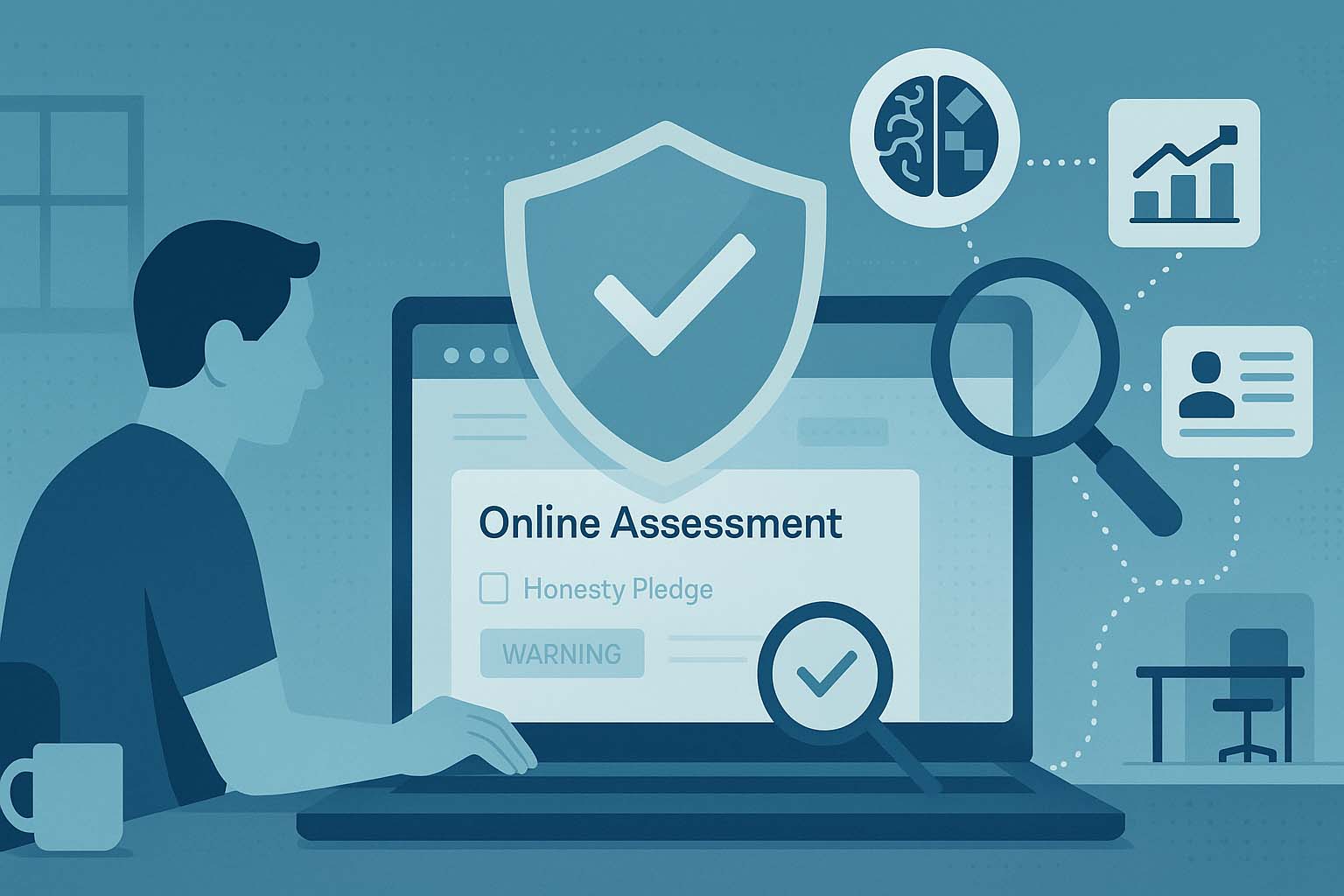Unproctored Internet Testing: What Really Deters Cheating?

Unproctored Internet Testing: What Really Deters Cheating?
Online pre-hire testing saves time and money, but can we trust the results when no one is watching? My master’s thesis tackled that question by running a real recruitment experiment with 110 job applicants to see whether common “cheating deterrence” tactics—warning messages and honesty pledges—actually work, and what separates cheaters from non-cheaters.
TL;DR
- Deterrence messages didn’t work. A warning + mandatory honesty pledge did not significantly reduce cheating compared to a control condition (25.5% vs. 39.6% cheating; total sample n=108).
- Cheaters scored lower on cognitive ability. On average, cheaters performed significantly worse on the cognitive test than non-cheaters (medium-to-large effect).
- Mindset matters. Cheaters reported stronger intentions to cheat and more lenient attitudes toward cheating. Differences in subjective norms and moral obligation were not statistically significant in this sample.
- Who cheated more? Recent grads did not cheat more than others in this study (non-significant difference).
The study at a glance
- Design: Real applicant pool from job ads; applicants randomly assigned to control vs. treatment (warning screen + explicit consequence messaging + mandatory honesty pledge) before a cognitive ability test.
- Sample: 110 applicants (108 used in the deterrence analysis).
- Measures: Cognitive ability (short Wonderlic form), embedded “cheating-detection” items, and a follow-up survey on personality (Big Five), impression management, and a modified TPB (attitudes, intentions, norms, perceived control, moral obligation).
- Cheating indicator: “Impossible” questions that can’t be solved without manipulating the test (e.g., browser/tech workarounds). Correct answers flagged likely cheating.
- Key result — Deterrence: Cheating rates Control 39.6% vs. Treatment 25.5% (not statistically significant).
- Key result — Ability: Cheaters scored significantly lower on cognitive ability than non-cheaters.
- Key result — Psychology: Cheaters reported higher intentions and more lenient attitudes toward cheating; subjective norms and moral obligation differences were not significant.
Why lower-ability candidates are more likely to cheat—and why it matters
In this study, applicants who cheated were significantly lower on the WPT-Q cognitive test than non-cheaters—a rarely examined difference in UIT research. Cognitive tests help ensure new hires meet the minimum ability required for the role; if lower-ability candidates are more prone to cheating, some may be placed above their level of competence, raising risks of poor performance, costly turnover, and even safety issues. A likely reason cheaters still scored lower on the WPT-Q is method mismatch: the cheating detected earlier relied on assisted/restricted technology, which doesn’t help on the WPT-Q’s timed, problem-solving items. Vendors also reduce item exposure and rotate forms, making tech-assisted shortcuts ineffective; while surrogate test-taking is possible, it’s harder to arrange and doesn’t guarantee a higher score.
“The finding that Cheaters scored significantly lower on the WPT-Q cognitive ability test in the context of personnel selection is a significant and relevant finding.” (Eren, 2018)
Practical takeaways for HR & Talent Acquisition
- Don’t rely on warnings. “We monitor for cheating” and honesty pledges look good for optics but don’t reliably change behaviour.
- Use design, not just declarations.
- Multi-hurdle design: Pair UIT with a later proctored verification step for shortlisted candidates (shorter, focused re-test).
- Consistency checks: Use item-type invariants or equated short forms to spot score spikes that don’t replicate.
- Cheating detection items: Keep (and refresh) embedded items that reveal tampering or external help.
- Score wisely. Weight verified scores (or consistency across assessments) more heavily in final decisions.
- Signal consequences you will actually enforce. If you warn about post-test verification, do the verification for those who advance.
- Balance candidate experience. Keep the process fair: be transparent about verification, keep re-tests short, and apply rules consistently.
- Audit impacts. Periodically monitor adverse-impact metrics, false positives/negatives on cheating flags, and the ROI of verification steps.
Why this matters for talent decisions
Unproctored tests are here to stay. But if warnings and pledges don’t curb cheating—and if cheaters tend to score lower on ability—then relying on deterrence messaging alone is risky. The good news: you can still use UIT, but you should design the process to catch or neutralize inflated scores without over-burdening candidates.
What this means for assessment strategy
- Validity risk: If deterrence doesn’t reliably reduce cheating, average UIT scores may be noisier. Building in verification reduces that noise and protects validity.
- Fairness & ethics: The data suggest that inflating scores doesn’t correlate with stronger ability—so cheating doesn’t just warp rankings; it can disadvantage truly qualified candidates.
- Where to invest: Rather than more legalese on a warning page, invest in verification design, item security, and analytics.
Limitations (and how to interpret the findings)
- Power & context. While the deterrence difference (39.6% → 25.5%) wasn’t statistically significant, the direction is suggestive; larger samples or different job contexts might detect small effects.
- Single test family. Results are based on one cognitive measure and a particular set of cheating-detection items; effects could vary by test type (e.g., simulations vs. knowledge tests).
- Behavioural flagging. “Impossible items” are a strong indicator, but like all detection methods, they can produce false negatives (undetected cheating) or rare false positives.






